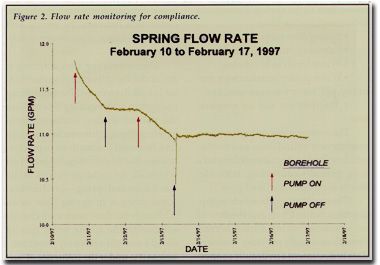



|
|
connection to the spring. Parameters to be monitored include:
The monitoring of spring flow rates records year-around flow, and continued monitoring documents flow for a long period--addressing both elements in compliance (see Figure 2) The monitoring of borehole pumping rates, water levels and the flow of an associated spring during normal operations usually provides sufficient data to document a hydraulic connection between the sprin and the borehole. Cycles of normal interruptions of flow during priduction--like turning pumps off and on during truck loading--cause a change in hydraulic conditions. Monitoring during these cycles records changes in spring flow due to the turning on and off of boreholes; these data |
 | |||
|
demonstrate a hydraulic connection between the spring and borehole--again, a necessary condition for its use. Documentation that a spring is not under the influence of surface water is best determined by monitoring changes in water quality. Springs are the natural surface discharge from aquifers. Precipitation recharges aquifers. Seasonal fluctuations in precipitation--like those in the semi-arid West where all the recharge occures in the late winter and spring--procuce seasonal changes in spring flow rates. Although the flow rates may change seasonally, the spring water quality should remain relatively constant...unless it is under the influence of surface water. Many commercial spring facilities are sampled for chemical analyses quarterly. These data aren't sufficient to prove or disprove whether a spring source is under the influence of surface water. The U.S. Environmental Protection Agency (USEPA) defines |
the microsopic particulate analysis (MPA) used to check for insects, algae, mold and other large pathogens typical of particulate matter associated with surface water. It's recommended that MPAs are done quarterly, but requirements for this vary between states. Missing from this typical sampling program is continuous water quality monitoring. Continuous monitoring is important to document the presence or absence of seasonal changes. Monitoring instrumentation has advanced to the point where key physical and chemical parameters are remotely measured at the spring or borehole(s) and recorded with on-site data loggers. Typically, systems are self contained, battery operated and can be recharged by solar cells. They commonly operate for a month or more without maintenance, with data retrieval available not only through direct periodic site visits, but via cellular phone or even by satellite. The remote data retrieval systems available aren't prohibitively expensive. |
|||